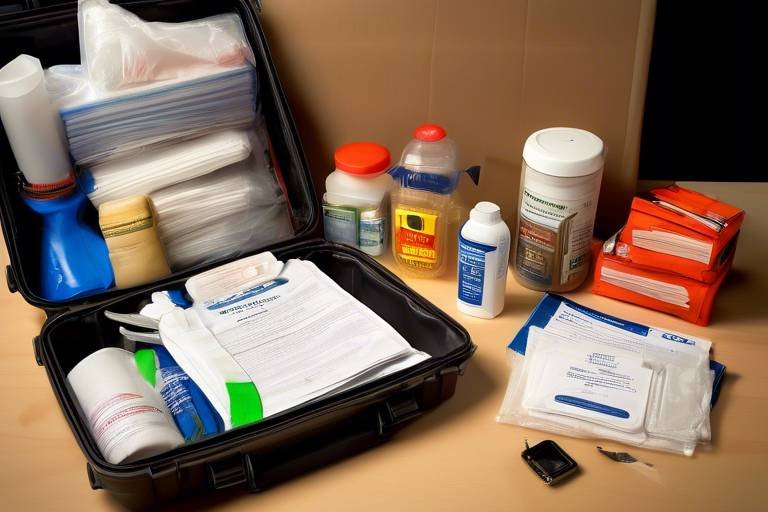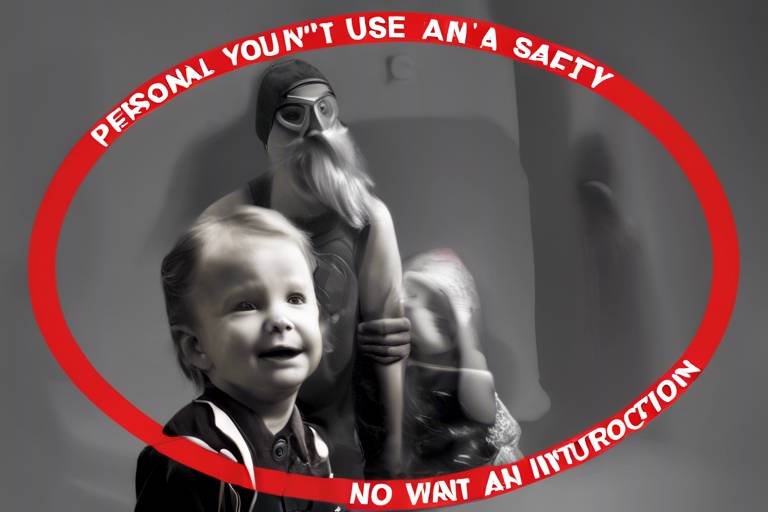The Impact of Climate Change on Personal Safety
Climate change isn't just a distant phenomenon that we can ignore or put off thinking about; it's a pressing reality that directly impacts our daily lives and personal safety. Imagine waking up one day to find that the weather patterns you’ve always relied on have shifted dramatically. This isn't just about warmer summers or slightly wetter winters; it's about an array of health risks, natural disasters, and social upheavals that can leave us feeling vulnerable and exposed. As temperatures rise and extreme weather events become more frequent, it’s essential to understand how these changes affect us on a personal level.
First off, let's talk about health risks. Rising temperatures can lead to heat-related illnesses, making it crucial for everyone, especially the elderly and those with pre-existing health conditions, to take precautions. Have you ever experienced a heatwave? It’s not just uncomfortable; it can be dangerous. You might find yourself sweating buckets, feeling dizzy, or even fainting. These aren’t just minor inconveniences; they can escalate into serious health crises.
Moreover, climate change is a breeding ground for respiratory issues. Poor air quality, often exacerbated by wildfires and pollution, can lead to chronic conditions like asthma. Picture this: you step outside, and instead of fresh air, you’re hit by a wave of smoke and smog. It’s not just unpleasant; it’s a health hazard. And let’s not forget about infectious diseases. With changing climates, diseases that were once confined to specific regions are now spreading, posing new threats to our health and safety.
Now, let’s dive into the realm of natural disasters. The frequency and intensity of events like hurricanes, floods, and wildfires are on the rise, and they can strike without warning. For instance, flooding can occur suddenly, leaving little time for preparation. In many areas, flooding has become a common occurrence, raising significant concerns about water safety and contamination. When floodwaters rise, they don't just threaten our homes; they jeopardize our access to clean water and essential services.
Flooding events are not just about the immediate danger; they also raise questions about long-term safety and health. Contaminated water can lead to outbreaks of diseases, making it imperative to have effective evacuation plans in place. Understanding how to prepare for potential flooding can save lives. Here are a few important steps:
- Create an emergency kit with essentials like food, water, and medical supplies.
- Have evacuation routes planned and know where to go in case of an emergency.
- Stay informed about weather alerts and local advisories.
Additionally, the impact of flooding on infrastructure cannot be overstated. Roads can become impassable, and access to essential services can be severely disrupted. This not only complicates evacuation efforts but can also delay emergency responses, putting lives at risk. Imagine being stuck in your home, unable to escape due to flooded roads, while help is just out of reach. It’s a terrifying thought, isn’t it?
As we continue to experience rising temperatures, heatwaves are becoming a regular occurrence. This isn't just an inconvenience; it’s a public health emergency. During these extreme heat events, it's vital to take preventive measures to protect yourself and those around you. Vulnerable populations, such as the elderly and individuals with chronic health issues, are particularly at risk. Simple actions like staying hydrated, avoiding strenuous activities during peak heat hours, and seeking air-conditioned spaces can make a significant difference.
Beyond health and natural disasters, climate change brings about profound social implications. Displacement due to extreme weather events can lead to resource scarcity, creating tensions within communities. When people are forced to leave their homes, they often find themselves in precarious situations, lacking access to basic needs. This not only affects their personal safety but can also destabilize entire communities.
As climate change forces people to relocate, understanding the challenges of displacement becomes crucial for maintaining personal safety. Communities may struggle to accommodate an influx of newcomers, leading to competition for resources like food, water, and shelter. This can create conflicts and increase vulnerability among already marginalized groups. It’s essential to foster understanding and cooperation among community members to mitigate these conflicts and enhance overall safety.
Building community resilience is key to navigating the challenges posed by climate change. By creating support networks and local initiatives, residents can share resources and information, enhancing personal safety in the face of adversity. Imagine a neighborhood where everyone looks out for one another, sharing supplies during a crisis and providing emotional support. This sense of community can be a powerful buffer against the impacts of climate change.
- What are the primary health risks associated with climate change? Rising temperatures can lead to heat-related illnesses, respiratory issues, and the spread of infectious diseases.
- How does climate change affect natural disasters? It increases the frequency and intensity of events like hurricanes, floods, and wildfires, posing significant threats to personal safety.
- What can I do to prepare for flooding? Create an emergency kit, plan evacuation routes, and stay informed about weather alerts.
- Why is community resilience important? It fosters collaboration and resource sharing, enhancing personal safety during climate-related events.

Health Risks Associated with Climate Change
As our planet warms, the effects of climate change are becoming increasingly evident, particularly when it comes to our health. Rising temperatures and shifting weather patterns are not just abstract concepts; they directly impact our well-being in profound ways. For instance, have you ever considered how a simple increase in temperature can lead to heat-related illnesses? These conditions, including heat exhaustion and heat stroke, can be life-threatening, especially for vulnerable populations like the elderly and those with chronic health issues.
Moreover, the air we breathe is also affected by climate change. As temperatures rise, so do the levels of air pollution, leading to respiratory problems such as asthma and chronic obstructive pulmonary disease (COPD). According to recent studies, the increase in ground-level ozone, a harmful air pollutant, is linked to higher temperatures, making it essential for everyone to monitor air quality, especially during heatwaves.
In addition to these immediate health risks, climate change is also a catalyst for the spread of infectious diseases. Warmer temperatures can expand the range of many disease-carrying vectors, like mosquitoes and ticks. Diseases such as malaria, dengue fever, and Lyme disease are becoming more common in areas where they were previously rare. This not only poses a direct threat to individual health but also places a strain on healthcare systems that are often unprepared for such outbreaks.
To illustrate the interconnectedness of these health risks, consider the following table that summarizes the primary health concerns associated with climate change:
| Health Risk | Description | Vulnerable Populations |
|---|---|---|
| Heat-related Illnesses | Conditions caused by excessive heat exposure | Elderly, children, and those with pre-existing health conditions |
| Respiratory Issues | Increased air pollution leading to asthma and COPD | Individuals with asthma, elderly, and outdoor workers |
| Infectious Diseases | Spread of diseases like malaria and dengue due to changing climates | People in tropical and subtropical regions |
As we navigate these challenges, it’s crucial to adopt proactive measures to safeguard our health. Staying informed about local weather conditions, using air conditioning during heatwaves, and taking precautions against insect bites can significantly reduce health risks. Additionally, communities must work together to develop strategies for public health education and emergency preparedness, ensuring that everyone has access to the resources they need to stay safe.
In conclusion, the health risks associated with climate change are a pressing concern that requires immediate attention. By understanding these risks and taking action, we can protect not only ourselves but also our communities. Remember, it’s not just about surviving; it’s about thriving in a changing world.

Natural Disasters and Their Effects
Climate change is not just an abstract concept; it’s a reality that’s reshaping our world, and one of the most alarming aspects of this shift is the increasing frequency and intensity of natural disasters. From hurricanes that batter coastlines to wildfires that rage through forests, the impacts of climate change are becoming more pronounced, and they pose significant threats to personal safety. Imagine waking up one day to find your town under evacuation orders due to an impending flood or hurricane. The fear and uncertainty can be overwhelming, and it’s a situation that is becoming all too common in many regions.
Natural disasters are not just isolated events; they create a ripple effect that can disrupt entire communities. When a hurricane hits, it doesn't just bring wind and rain; it can lead to power outages, loss of communication, and damage to infrastructure. This means that access to essential services like healthcare, food, and clean water can be severely compromised. The emotional toll is equally significant, as families may be displaced, homes destroyed, and lives altered forever. It's crucial to recognize that these disasters are not just environmental issues; they are deeply intertwined with our personal safety and well-being.
According to recent studies, the number of climate-related disasters has increased dramatically over the past few decades. For instance, a report from the Intergovernmental Panel on Climate Change (IPCC) highlights that the occurrence of extreme weather events has risen by over 50% since the 1980s. This alarming trend underscores the urgent need for effective preparedness and response strategies. Communities must come together to create robust emergency plans that can mitigate the impacts of these disasters.
One of the most pressing concerns related to natural disasters is flooding, which has become more common due to rising sea levels and increased rainfall. Flooding can lead to severe water safety issues, including contamination of drinking water supplies and the spread of waterborne diseases. In fact, the World Health Organization (WHO) estimates that flooding events can increase the risk of diseases like cholera and hepatitis A. Therefore, understanding how to prepare for potential flooding is essential for protecting personal safety.
So, how can individuals and communities prepare for floods? Here are some key strategies:
- Create Emergency Kits: Having a well-stocked emergency kit can make a significant difference in a crisis. Include essentials like water, non-perishable food, medications, flashlights, and batteries.
- Plan Evacuation Routes: Knowing where to go and how to get there in case of an emergency can save lives. Familiarize yourself with local evacuation routes and keep them updated.
- Stay Informed: Regularly check weather alerts and updates from local authorities. Being informed can help you make timely decisions.
Moreover, the impact of flooding extends beyond immediate safety concerns; it can also severely damage infrastructure. Roads, bridges, and public transport systems can be compromised, making it difficult for emergency services to reach those in need. This disruption can further endanger personal safety during emergencies, as access to essential services becomes limited. Communities must prioritize investing in resilient infrastructure to withstand the impacts of flooding and other natural disasters.
In addition to floods, heatwaves are another consequence of climate change that demands our attention. Increasing temperatures can lead to heat-related illnesses, particularly among vulnerable populations such as the elderly and those with pre-existing health conditions. It’s vital to recognize that these extreme heat events are not just uncomfortable; they can be deadly. Taking precautions, such as staying hydrated, seeking shade, and avoiding strenuous activities during peak heat hours, is essential for safeguarding personal safety.
In conclusion, the effects of natural disasters driven by climate change are profound and far-reaching. As individuals, we must stay informed, be prepared, and work together as communities to face these challenges head-on. The more proactive we are in our approach to disaster preparedness, the better we can protect ourselves and our loved ones from the unpredictable forces of nature.
- What should I include in my emergency kit? An emergency kit should include water, non-perishable food, medications, first aid supplies, flashlights, batteries, and important documents.
- How can I stay informed about natural disasters? Regularly check local news, weather apps, and alerts from government agencies to stay updated on potential natural disasters.
- What are the signs of heat-related illnesses? Symptoms include heavy sweating, weakness, dizziness, nausea, and headache. If you experience these, seek shade and hydrate immediately.
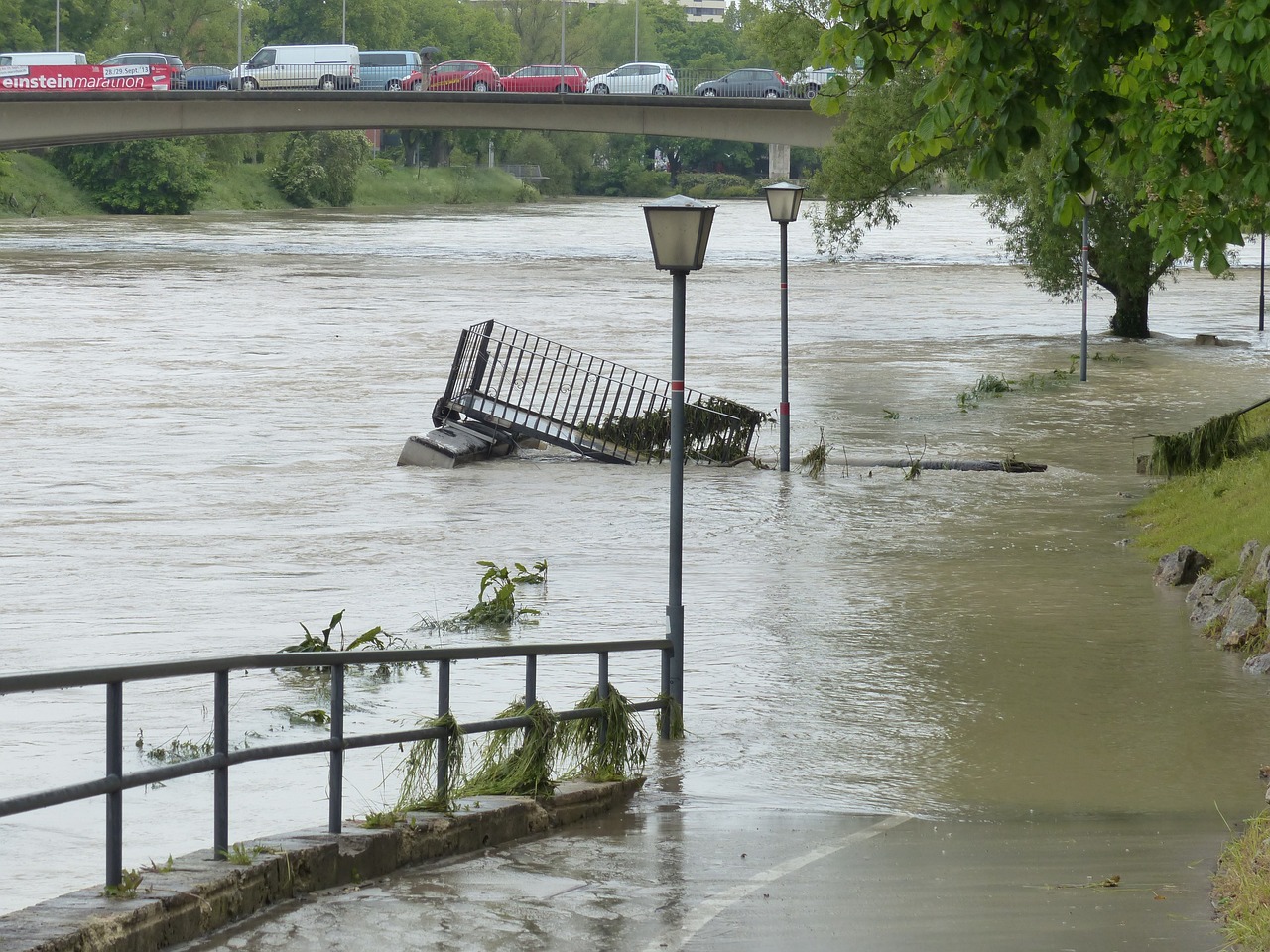
Flooding and Water Safety
Flooding events are becoming more frequent and severe, largely due to the impacts of climate change. These occurrences can transform a once-peaceful neighborhood into a chaotic scene of rushing water and uncertainty. The implications of flooding extend beyond just the immediate danger; they also raise significant concerns about water safety and contamination. When floodwaters surge, they often carry pollutants, debris, and harmful microorganisms that can pose serious health risks. This situation not only threatens personal safety but also underscores the importance of being prepared and informed.
Imagine waking up one morning to find your street submerged, your home at risk, and your community in a state of emergency. The psychological toll of such an event can be as damaging as the physical dangers it presents. To mitigate these risks, it's crucial to have effective evacuation plans and to stay updated on weather alerts. Communities need to come together to develop and maintain these plans, ensuring that everyone knows what to do when the waters rise.
One of the key aspects of flood safety is understanding the potential for water contamination. Floodwaters can easily mix with sewage, chemicals, and other hazardous materials, making them unsafe for drinking or even contact. In fact, the Centers for Disease Control and Prevention (CDC) warns that floodwaters can harbor a variety of pathogens that can lead to illnesses. Therefore, it's essential for individuals to take precautions, such as:
- Staying indoors during a flood event.
- Avoiding contact with floodwaters whenever possible.
- Using bottled or boiled water for drinking and cooking until the water supply is deemed safe.
Additionally, the impact of flooding on infrastructure cannot be overlooked. Roads, bridges, and public transportation systems can be severely compromised, making it difficult for emergency responders to reach those in need. This disruption can exacerbate the already precarious situation, leading to delays in evacuation and rescue efforts. Communities must prioritize building resilient infrastructure that can withstand flooding events, incorporating measures such as improved drainage systems and flood barriers.
Ultimately, the key to ensuring safety during flooding lies in preparation and community awareness. By coming together and sharing resources, communities can create a robust support system that not only aids during emergencies but also fosters a sense of unity and resilience. It's essential to conduct regular drills and community meetings to keep everyone informed and ready to act when the waters rise. After all, in the face of climate change, our safety is intertwined with the strength of our communities.
Q: What should I do if I am caught in a flood?
A: If you find yourself in a flood, seek higher ground immediately. Avoid walking or driving through floodwaters, as they can be deeper and more dangerous than they appear. Listen to local authorities for updates and follow evacuation orders if given.
Q: How can I prepare my home for potential flooding?
A: To prepare your home, consider elevating electrical appliances and utilities, installing sump pumps, and creating a flood emergency kit that includes essentials like water, food, medications, and important documents.
Q: What are the signs of water contamination after a flood?
A: Signs of water contamination can include discoloration, an unusual odor, and the presence of debris or sediment. Always assume floodwaters are contaminated and avoid using them for drinking or cooking.

Emergency Preparedness for Floods
When it comes to floods, preparation is not just a good idea; it’s a necessity. Imagine waking up to find your neighborhood submerged in water, your belongings floating away, and the roads impassable. This scenario is increasingly becoming a reality for many due to climate change. To protect yourself and your loved ones, it’s essential to have a solid emergency plan in place. This involves a few key steps that can make all the difference when disaster strikes.
First and foremost, creating an emergency kit is crucial. This kit should include basic supplies that can sustain you and your family for at least 72 hours. Think of it as your lifeboat in a storm. Here’s a quick checklist of what to include:
- Non-perishable food items
- Water (at least one gallon per person per day)
- Flashlights and extra batteries
- First aid supplies
- Essential medications
- Important documents (ID, insurance papers, etc.)
- Cash in small denominations
Next, having a well-thought-out evacuation plan is critical. This means knowing your local evacuation routes and having a predetermined meeting place for your family. It’s like having a roadmap in a foreign land; it ensures you won’t get lost when the waters rise. Make sure to practice this plan regularly so everyone knows what to do when the time comes.
Staying informed about weather alerts is another vital part of your preparedness strategy. With technology at our fingertips, it’s easier than ever to keep track of potential flood threats. Sign up for local alerts and download weather apps that provide real-time updates. Think of these alerts as your early warning system, giving you precious time to act before it’s too late.
Moreover, it’s important to understand the infrastructure in your area. Flooding can severely damage roads, bridges, and other critical services. Familiarize yourself with your community’s emergency resources, such as shelters and medical facilities. Knowing where to go in an emergency can significantly enhance your personal safety.
Lastly, consider engaging with your community. Building relationships with neighbors can create a support network that will be invaluable during a flood. Whether it’s sharing resources, information, or simply having someone to check on, community ties can foster resilience. After all, in times of crisis, we are often stronger together.
Q: What should I do if I receive a flood warning?
A: If you receive a flood warning, it’s essential to take immediate action. Gather your emergency kit, secure your home, and follow local evacuation orders. Stay informed through local news and weather apps.
Q: How can I protect my property from flooding?
A: You can take several steps to protect your property, including elevating electrical appliances, installing sump pumps, and creating barriers with sandbags. Regularly check your gutters and drainage systems to ensure they are clear.
Q: What should I do if I’m trapped in my home during a flood?
A: If you find yourself trapped, move to the highest level of your home and signal for help. Use a whistle or your phone to alert rescuers. Avoid using electrical appliances and stay away from windows.
Q: How can I help my community prepare for floods?
A: You can help by organizing community preparedness meetings, sharing resources, and encouraging your neighbors to create their emergency plans and kits. Together, you can build a more resilient community.
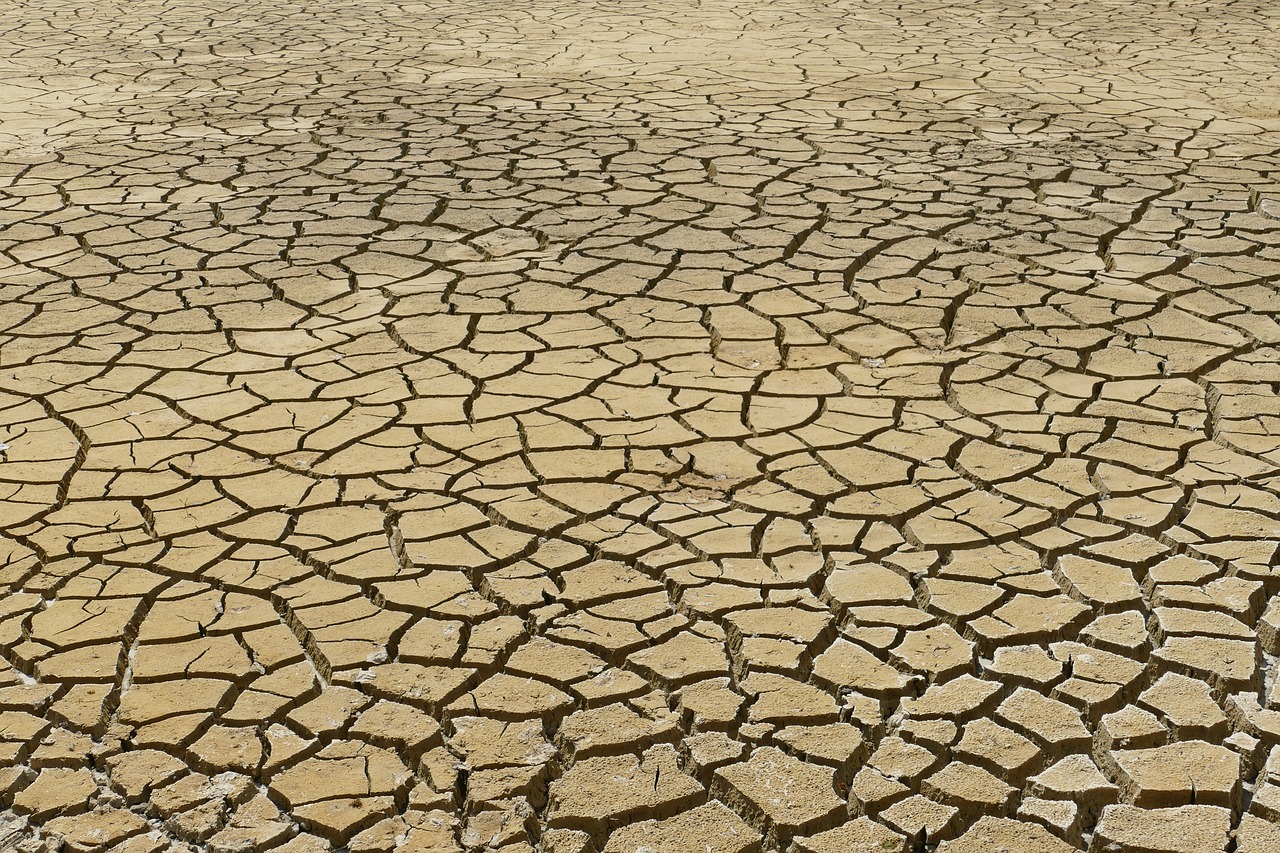
Impact on Infrastructure
The impact of climate change on infrastructure is a pressing concern that cannot be overlooked. As flooding, hurricanes, and wildfires become increasingly common, our roads, bridges, and public utilities are at greater risk than ever. Imagine waking up one day to find your usual route to work submerged in water or your local hospital unable to operate due to power outages caused by a severe storm. These scenarios are becoming more likely as climate change progresses, highlighting the urgent need for robust infrastructure that can withstand extreme weather events.
When we talk about infrastructure, we refer to the essential systems that support our daily lives, including transportation networks, water supply systems, and energy grids. Climate change disrupts these systems in several ways:
- Physical Damage: Floodwaters can erode roadways and bridges, while strong winds can topple power lines and damage buildings. This physical destruction can lead to dangerous situations, such as accidents and delays in emergency response.
- Access to Resources: Disrupted infrastructure can hinder access to clean water, healthcare, and food supplies, putting communities at risk. For instance, if a flood damages a water treatment facility, residents may be left without safe drinking water for days or even weeks.
- Economic Consequences: The financial burden of repairing damaged infrastructure can be staggering. Local governments may struggle to allocate funds for repairs, affecting other essential services like education and public safety.
Moreover, the impact of climate change on infrastructure extends beyond immediate physical damage. It can also lead to long-term vulnerabilities. For example, if a community experiences frequent flooding, residents may become less willing to invest in their homes or businesses, leading to decreased property values and economic decline. This cycle of deterioration can create a domino effect, where one problem exacerbates another, ultimately compromising personal safety.
To mitigate these risks, it's essential for communities to adopt proactive measures. This includes investing in resilient infrastructure that can withstand extreme weather, enhancing drainage systems to prevent flooding, and developing emergency response plans that take into account the potential for infrastructure failure. By prioritizing these strategies, we can create safer environments that protect individuals and communities from the adverse effects of climate change.
Q: How can communities prepare for the impact of climate change on infrastructure?
A: Communities can prepare by investing in resilient infrastructure, enhancing drainage systems, and developing comprehensive emergency response plans that address potential infrastructure failures.
Q: What are some examples of resilient infrastructure?
A: Examples include elevated roads, flood-resistant buildings, and improved stormwater management systems that can handle increased rainfall and flooding.
Q: How does climate change affect emergency response times?
A: Damage to roads and bridges can delay emergency responders, making it harder to reach those in need during disasters.
Q: Why is it important to address the economic consequences of climate change on infrastructure?
A: Addressing these economic consequences is crucial to ensure that communities can maintain essential services and protect residents from further vulnerabilities.

Heatwaves and Health Precautions
As the planet warms, heatwaves are becoming more frequent and intense, transforming the way we think about our health and safety. Imagine stepping outside into a wall of heat, where even a short walk feels like running a marathon. That's the reality many of us face during these scorching days. Heatwaves can lead to serious health issues, including heat exhaustion and heat stroke, particularly among vulnerable populations such as the elderly, children, and those with pre-existing health conditions. So, what can we do to protect ourselves and our loved ones?
First and foremost, it's essential to stay hydrated. Water is your best friend during a heatwave. Dehydration can sneak up on you, leading to dizziness and confusion. Aim to drink at least eight glasses of water a day, and even more if you're sweating heavily. It’s also wise to avoid caffeine and alcohol, as these can contribute to dehydration.
Next, consider your daily activities. If possible, try to limit outdoor activities during the hottest parts of the day, typically between 10 AM and 4 PM. If you must go outside, wear light-colored, loose-fitting clothing to help your body stay cool. A wide-brimmed hat and sunglasses can also provide much-needed shade and protection from the sun's harmful rays.
Another critical aspect of heatwave safety is to keep your living environment cool. Use fans, air conditioning, or even wet towels to lower your body temperature. If you don’t have air conditioning, consider spending time in public places like malls or libraries that do. Remember, your home should be a safe haven, and keeping it cool can significantly reduce the risk of heat-related illnesses.
It's not just about personal safety, though. Community awareness plays a vital role in combating the dangers of heatwaves. Check in on your neighbors, especially those who may be isolated or elderly. A simple phone call or visit can make a world of difference. Establishing a community support network can ensure that everyone is looking out for one another during extreme heat events.
In summary, heatwaves are no joke, and taking precautions is crucial for maintaining personal health and safety. By staying hydrated, avoiding strenuous activities during peak heat, keeping your environment cool, and fostering community connections, you can significantly reduce the risks associated with these extreme weather events. Remember, the more prepared you are, the safer you’ll be!
- What are the signs of heat exhaustion? Symptoms include heavy sweating, weakness, cold, pale, and clammy skin, fast or weak pulse, nausea, and fainting.
- How can I cool down quickly? Move to a cooler place, drink water, and apply cool, wet cloths to your body.
- Who is most at risk during a heatwave? Vulnerable populations include the elderly, young children, and individuals with chronic health conditions.
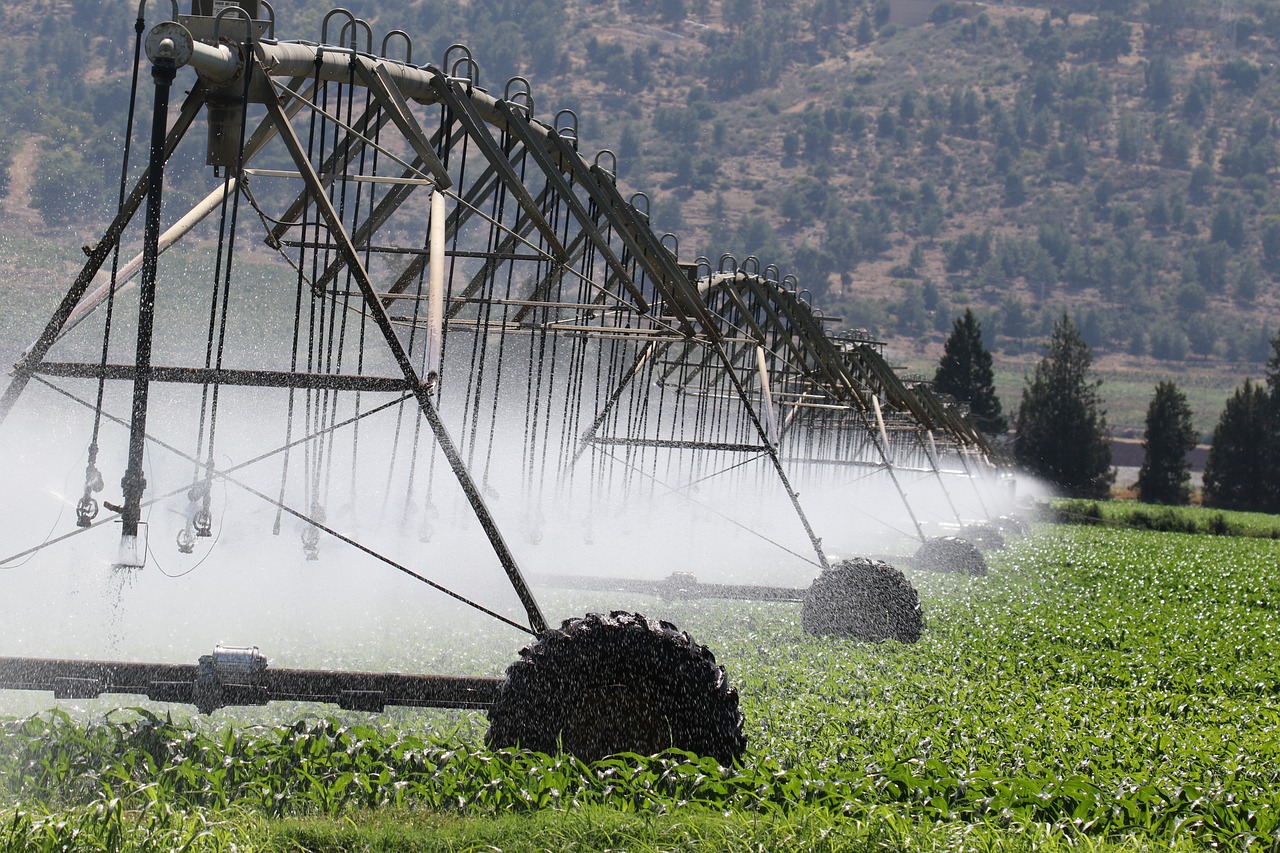
Social Implications of Climate Change
The social ramifications of climate change are profound and multifaceted, affecting not just the environment but also the very fabric of our communities. As we witness shifting climates, we’re also seeing a rise in **displacement** and **resource scarcity**, which can lead to conflicts and increased vulnerability. These changes challenge the stability of communities and the safety of individuals, making it imperative that we understand the implications of climate change on our social structures.
One of the most alarming consequences of climate change is the displacement of populations. As natural disasters become more frequent and severe, entire communities are forced to abandon their homes. This displacement can lead to a number of challenges, including:
- Loss of Community: When people are uprooted from their homes, they often lose their support systems, which can lead to feelings of isolation and despair.
- Increased Competition for Resources: As displaced populations move into new areas, they may compete with local residents for jobs, housing, and essential services, exacerbating tensions.
- Vulnerability to Exploitation: Displaced individuals may find themselves in precarious situations, making them targets for exploitation and abuse.
Moreover, climate change doesn’t just affect those who are displaced; it also impacts those who remain in their communities. Resource scarcity is a growing concern, as changing weather patterns can lead to droughts, reduced agricultural yields, and limited access to clean water. This scarcity can create a breeding ground for **conflict** and **social unrest**. Communities may find themselves at odds over dwindling resources, leading to a breakdown in social cohesion.
To combat these challenges, it is essential for communities to foster resilience and support networks. Building community resilience means creating systems that can withstand the pressures of climate change. This can include:
- Local Initiatives: Programs that promote sustainability and resource sharing can help communities adapt to changing conditions.
- Support Networks: Establishing networks that provide emotional and practical support can enhance community bonds and improve overall safety.
- Education and Awareness: Raising awareness about the effects of climate change can empower individuals to take action and support one another.
In summary, the social implications of climate change are vast and complex, affecting personal safety and community stability. As we navigate these challenges, it is crucial to prioritize community resilience and support systems to ensure that we can adapt and thrive in an increasingly uncertain world.
Q: How does climate change lead to displacement?
A: Climate change can cause natural disasters such as floods and hurricanes, forcing people to leave their homes. Additionally, prolonged droughts and resource scarcity can make areas uninhabitable.
Q: What are some ways communities can build resilience?
A: Communities can build resilience through local initiatives that promote sustainability, establishing support networks for residents, and providing education on climate change and its impacts.
Q: How can individuals prepare for the social impacts of climate change?
A: Individuals can prepare by getting involved in local community efforts, staying informed about climate issues, and building strong relationships with neighbors to create a supportive network.

Displacement and Migration Issues
As climate change continues to wreak havoc on our planet, the issue of displacement and migration is becoming increasingly urgent. Imagine waking up one day to find that your home has been rendered uninhabitable due to rising sea levels or devastating wildfires. This is the harsh reality for many individuals and families around the globe. Climate-induced migration is not just a distant concern; it’s happening now, and it affects millions. People are forced to leave their homes, often with little more than the clothes on their backs, seeking safety and stability in unfamiliar territories.
The challenges that arise from this mass movement of people are multifaceted. First and foremost, displaced individuals often face significant barriers to accessing basic needs such as food, shelter, and healthcare. As communities swell with newcomers, resources can become stretched thin, leading to heightened tensions and competition for limited supplies. The social fabric of these areas can become frayed, as long-term residents may feel threatened by the influx of new populations. This can lead to a rise in xenophobia and social unrest, further complicating the situation.
Moreover, the psychological toll on displaced individuals cannot be overstated. Leaving behind familiar surroundings, friends, and family can lead to feelings of isolation and despair. The trauma of losing one’s home, coupled with the uncertainty of the future, can have lasting impacts on mental health. In many cases, displaced populations may struggle to find a sense of belonging in their new environments, which can exacerbate feelings of vulnerability.
To better understand the scale of climate-induced displacement, consider the following statistics:
| Year | Estimated Displaced Individuals |
|---|---|
| 2018 | 17.2 million |
| 2019 | 24.9 million |
| 2020 | 30.7 million |
These numbers highlight the growing trend of climate-induced displacement and the urgent need for comprehensive strategies to address the challenges faced by these individuals. Governments and organizations must work together to create policies that not only support displaced populations but also foster community integration and resilience. This can include providing access to education, job training, and mental health services, which are critical for helping individuals rebuild their lives.
In conclusion, the issues surrounding displacement and migration due to climate change are complex and require immediate attention. As we navigate this new reality, it’s essential to foster a sense of community and support for those affected. By doing so, we can help ensure that personal safety and stability are not just distant dreams, but attainable realities for everyone.
- What are the main causes of climate-induced displacement? Climate-induced displacement is primarily caused by extreme weather events, rising sea levels, and long-term environmental changes, all of which are exacerbated by climate change.
- How can communities support displaced individuals? Communities can support displaced individuals by providing access to essential services, fostering social integration, and creating support networks that offer emotional and practical assistance.
- What role do governments play in addressing displacement issues? Governments play a crucial role in creating policies that protect the rights of displaced individuals, ensuring access to resources, and promoting community resilience.

Community Resilience and Support
As climate change continues to reshape our environment, the importance of community resilience has never been more critical. Communities that come together to support one another not only enhance their chances of survival during crises but also foster a sense of belonging and solidarity. Think of it like a well-oiled machine; each part has a role to play, and when one part is in sync with the others, the entire system functions smoothly. So, how can communities build this resilience? It starts with creating strong support networks.
One effective way to enhance community resilience is through local initiatives. These initiatives can range from organizing neighborhood watch programs to establishing community gardens. When residents actively participate in these programs, they not only learn valuable skills but also forge connections with their neighbors. For instance, a community garden can serve as a hub for social interaction while providing fresh produce, which is especially important during times of resource scarcity. By working together, community members can share knowledge, tools, and even food, creating a safety net for everyone involved.
Moreover, communication is key. In times of crisis, having a robust communication plan can make all the difference. Communities should establish platforms—like social media groups or local apps—where residents can quickly share information about emergencies, resources, or even just check in on each other. Imagine knowing that your neighbor has an extra generator during a power outage; that kind of information can be lifesaving. Regular community meetings can also help keep everyone informed and engaged, ensuring that no one feels isolated or unsupported.
To further illustrate the impact of community resilience, consider the following table that outlines various strategies and their benefits:
| Strategy | Benefits |
|---|---|
| Community Gardens | Access to fresh food, social interaction, and skills sharing |
| Emergency Communication Plans | Quick dissemination of information, increased awareness, and support |
| Local Training Workshops | Skill development, increased self-sufficiency, and preparedness |
| Support Networks | Emotional support, resource sharing, and reduced isolation |
In addition to these strategies, fostering a culture of collaboration is crucial. When individuals feel empowered to contribute their unique skills and talents, the entire community benefits. This could mean organizing workshops where people can teach each other practical skills, like first aid or food preservation techniques. By pooling resources and knowledge, communities can become more self-reliant and better equipped to handle the challenges posed by climate change.
Ultimately, the strength of a community lies in its people. By building connections, sharing resources, and supporting one another, we can create a resilient network that can withstand the pressures of climate change. So, let’s take the initiative to reach out to our neighbors, participate in local programs, and cultivate a spirit of cooperation. Together, we can not only enhance our personal safety but also foster a thriving community that stands strong in the face of adversity.
- What is community resilience? Community resilience refers to the ability of a community to withstand and recover from adverse situations, such as natural disasters or social upheaval.
- How can I get involved in my community? You can start by attending local meetings, joining community groups, or volunteering for local initiatives.
- Why is communication important in building resilience? Effective communication ensures that community members are informed, connected, and able to support each other during crises.
- What are some examples of local initiatives? Examples include community gardens, neighborhood watch programs, and skill-sharing workshops.
Frequently Asked Questions
- How does climate change affect personal safety?
Climate change poses various threats to personal safety, including increased health risks like heat-related illnesses and respiratory issues, as well as the heightened frequency and intensity of natural disasters such as hurricanes, floods, and wildfires. These factors can disrupt communities and infrastructure, making it essential to understand and prepare for these changes.
- What health risks are associated with climate change?
As temperatures rise and weather patterns shift, individuals may face several health risks. These include heat-related illnesses, respiratory problems due to poor air quality, and the spread of infectious diseases. Vulnerable populations, such as the elderly and those with pre-existing conditions, are particularly at risk and need to take extra precautions.
- How can I prepare for flooding events?
Preparation for flooding is crucial to ensure personal safety. It's important to create an emergency kit that includes essentials like water, food, and first-aid supplies. Additionally, having a clear evacuation plan and staying updated on weather alerts can significantly enhance your safety during a flood.
- What should I do during a heatwave?
During a heatwave, it's vital to stay hydrated and avoid strenuous activities during peak heat hours. Seek shade or air-conditioned spaces, especially for vulnerable individuals like the elderly. Wearing lightweight, loose-fitting clothing can also help mitigate heat-related illnesses.
- How does climate change lead to social issues?
Climate change can exacerbate social issues by causing displacement and resource scarcity. As communities face the impacts of climate change, conflicts may arise over dwindling resources, which can increase vulnerability and threaten community stability. Understanding these dynamics is essential for fostering resilience.
- What can communities do to enhance resilience against climate change?
Building community resilience involves creating support networks and engaging in local initiatives that promote collaboration and resource sharing. Communities can work together to develop emergency plans, share information, and support one another, which can significantly enhance personal safety in the face of climate challenges.
















